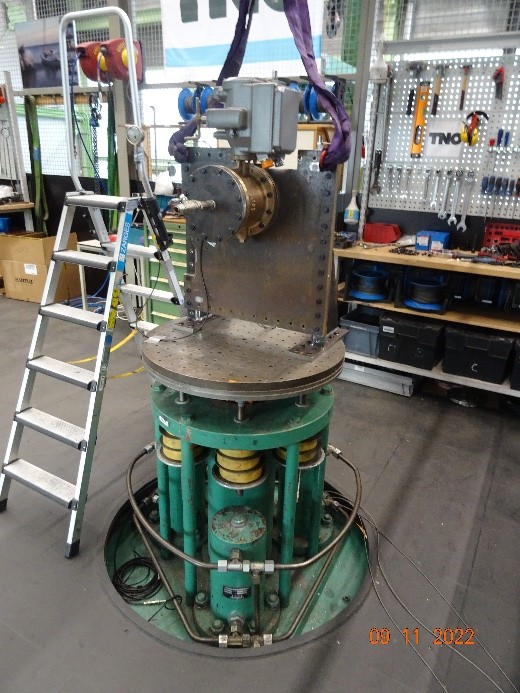Light-weight Vertical Shock Machine
- Category:
- Laboratory
- Brand:
- TNO
- Type:
- LVSM

Description
With over 55 years of experience, TNO provides practical Naval shock expertise and knowledge for a world-wide customer base. The test facilities at the TNO Structural Dynamics lab have been developed to simulate the effect of shock loading generated from a non-contact underwater explosion (UNDEX).
The TNO shock machines can be used to meet the requirements from the international Naval standards: BR3021 (incl. NSS1 and NSS2; 1970s, UK), BR8470 (1989, UK), MAP 01-470 (2012, UK), BV043 (1985/1989, DE) and BV0230 (2017, NL/DE).
Technical details
The TNO light-weight vertical shock machine (LVSM) has a round mounting surface with a diameter of 0.75m. The maximum payload is 500kg. Maximum displacements of 120mm can be achieved along with a maximum velocity of 15m/s and a maximum acceleration of 800g. Based on the setup of the LVSM, the pulse duration can vary between 3ms to 25ms.
All values above are indicative and, in the situation where the payload exceeds the capacity, the required pulse duration is shorter or longer, or the required acceleration differs from the one stated above, TNO endeavors to provide solutions.
Additional techniques
State-of-the-art instrumentation is used to measure the applied shocks. TNO uses high-accuracy, regularly calibrated piezo-resistive accelerometers. Pressure and strain can also be measured during the shock. For electrical systems, the bounce on contacts and switches can be monitored during the shock event. All tests are filmed using a high speed video camera (6400 fps). The expertise of TNO in instrumentation and post-processing also includes high speed 2D and 3D optical strain (digital image correlation) measurements.
Applications
The TNO shock machines satisfy the requirements from the well-known international Naval standards. Furthermore, they can be adjusted to satisfy specific customer’s requirements, including simulating the loading in an above resilient mount environment.
Tests are validated in both the time domain (acceleration, velocity and displacement) and using the Shock Response Spectrum (SRS) approach in the frequency domain. The latter using the qualification criteria from NATO STANAG 4549 (2000, TNO).